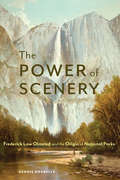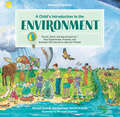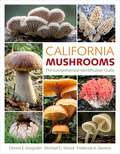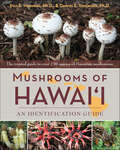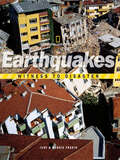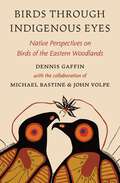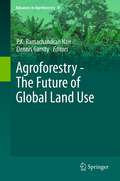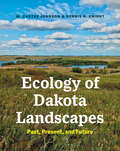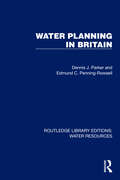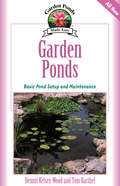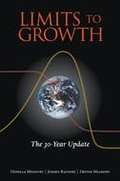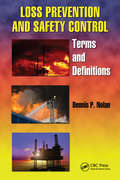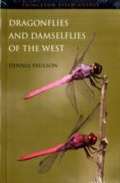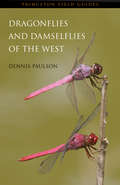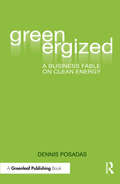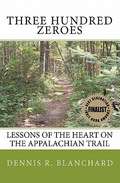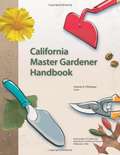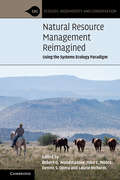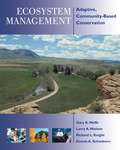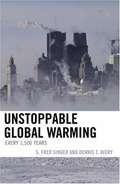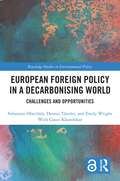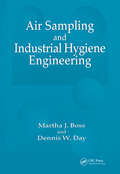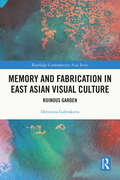- Table View
- List View
The Power of Scenery: Frederick Law Olmsted and the Origin of National Parks
by Dennis DrabelleWallace Stegner called national parks &“the best idea we ever had.&” As Americans celebrate the 150th anniversary of Yellowstone, the world&’s first national park, a question naturally arises: where did the idea for a national park originate? The answer starts with a look at pre-Yellowstone America. With nothing to put up against Europe&’s cultural pearls—its cathedrals, castles, and museums—Americans came to realize that their plentitude of natural wonders might compensate for the dearth of manmade attractions. That insight guided the great landscape architect Frederick Law Olmsted as he organized his thoughts on how to manage the wilderness park centered on Yosemite Valley, a state-owned predecessor to the national park model of Yellowstone. Haunting those thoughts were the cluttered and carnival-like banks of Niagara Falls, which served as an oft-cited example of what should not happen to a spectacular natural phenomenon. Olmsted saw city parks as vital to the pursuit of happiness and wanted them to be established for all to enjoy. When he wrote down his philosophy for managing Yosemite, a new and different kind of park, one that preserves a great natural site in the wilds, he had no idea that he was creating a visionary blueprint for national parks to come. Dennis Drabelle provides a history of the national park concept, adding to our understanding of American environmental thought and linking Olmsted with three of the country&’s national treasures. Published in time to celebrate the 150th anniversary of Yellowstone National Park on March 1, 2022, and the 200th birthday of Frederick Law Olmsted on April 26, 2022, The Power of Scenery tells the fascinating story of how the national park movement arose, evolved, and has spread around the world.
A Child's Introduction to the Environment: The Air, Earth, and Sea Around Us -- Plus Experiments, Projects, and Activities YOU Can Do to Help Our Planet! (A Child's Introduction Series)
by Michael Driscoll Dennis DriscollExplore the water, land, and air around us with this entertaining and informative look at our magnificent planet—and learn how your experiments, activities, and everyday actions can help save the environment. This book looks at the wide variety of ecosystems and environmental regions of the Earth, from deserts and forests, to cities and farms, to oceans and ice caps, as well as the atmosphere, weather, energy sources, plants, and animals of each area. Michael Driscoll and professor of meteorology Dennis Driscoll explain the changes to our planet that are currently taking place, including rising temperatures and sea levels, and the effects they can have on our environment. They also profile young environmental activists like Greta Thunberg and Isra Hirsi, and highlight important, everyday actions such as water conversion and recycling that kids can do on their own or with their parents. Also included are fun projects and experiments to do at home like brewing sun tea, creating lightning, and making a smog detector. Packed with facts, experiments, and a removable poster with tips on how to save the planet, this comprehensive guide will inspire kids and their families to think about our planet in new ways and help keep it beautiful and healthy for years to come.
California Mushrooms: The Comprehensive Identification Guide
by Michael G. Wood Dennis E. Desjardin Frederick A. StevensWinner of the CBHL Award of Excellence California is one of the most ecologically rich and diverse regions of North America, and home to hundreds of species of mushrooms. In California Mushrooms, mycologist experts Dennis Desjardin, Michael Wood, and Fred Stevens provide over 1100 species profiles, including comprehensive descriptions and spectacular photographs. Each profile includes information on macro- and micromorphology, habitat, edibility, and comparisons with closely related species and potential look-alikes. Although the focus of the book is on mushrooms of California, over 90% of the species treated occur elsewhere, making the book useful throughout western North America. This complete reference covers everything necessary for the mushroom hunter to accurately identify over 650 species.
Mushrooms of Hawai'i: An Identification Guide
by Dennis E. Desjardin Don E. HemmesHawai'i is known for its verdant mountains and colorful ocean ecosystems, but few realize the depth and range of the islands' mushroom diversity. In fact, Hawai'i is home to over 230 species of mushrooms that are prized by foragers from around the world. In Mushrooms of Hawai'i, Don Hemmes and Dennis Desjardin present a beautiful and comprehensive guide to the treasure trove of mycological life in the Aloha State. Inside you'll find information on Mushroom identification Culinary and medicinal uses of Hawaiian mushrooms Where to find the best mushroom-hunting spots The seasonality of Hawaiian mushrooms And everything else you might need to make your foraging adventure a success. Mushrooms of Hawai'i also includes beautiful illustrations to help you identify familiar treasures like morels, well-known dangers like Amanita muscaria, and exciting species unique to the islands. Whether you're hunting Copelandia cyanescens ("magic" mushrooms) in the pasture grasses high in the mountains of Maui, or foraging for Laetiporus (chicken of the woods), an edible mushroom sought after by foodies for its uniquely delicious taste, this book is the must-have guide for fungophiles.
¡Incendio forestal! (¡Arriba la Lectura!, Level J #20)
by Dennis FertigWon, Víctor y Beth quieren saber más sobre los incendios forestales. Una guardabosques responde a todas sus preguntas. NIMAC-sourced textbook
Witness to Disaster: Witness to Disaster (Witness to Disaster)
by Dennis Fradin Judy FradinIt&’s another normal day in Alaska, where the beauty of the rugged landscape makes the hardships of winter worth enduring. This Northern life is good, you think, when suddenly—without warning—your world is ROCKED! The ground sways beneath your feet with sickening force. You&’ve just been caught in the second strongest earthquake in history! Witness to Disaster: Earthquakes uses eyewitness accounts and pulse-racing narrative to bring readers into the terrifying heart of an earthquake. The first chapter documents the 1964 Alaskan quake that shook Prince William Sound with a 9.2 magnitude force, and set off a tsunami that ultimately caused most of the deaths attributed to this frightening act of nature. The following chapters explore the deadly history of earthquakes and the seismic and geological science of this phenomenon. Readers learn how and why earthquakes occur, and what scientists can do to prevent casualties. The expansive back matter includes a list of sources to discover more about these fearsome catastrophes.
Birds through Indigenous Eyes: Native Perspectives on Birds of the Eastern Woodlands
by Dennis GaffinAn intimate and personal account of the profound roles birds play in the lives of some Indigenous peopleFor many hours over a period of years, white anthropologist Dennis Gaffin and two Indigenous friends, Michael Bastine and John Volpe, recorded their conversations about a shared passion: the birds of upstate New York and southern Ontario. In these lively, informal talks, Bastine (a healer and naturalist of Algonquin descent) and Volpe (a naturalist and animal rehabilitator of Ojibwe and Métis descent) shared their experiences of, and beliefs about, birds, describing the profound spiritual, psychological, and social roles of birds in the lives of some Indigenous people. Birds through Indigenous Eyes presents highlights of these conversations, placing them in context and showing how Native understandings of birds contrast with conventional Western views.Bastine and Volpe bring to life Algonquin, Ojibwe, and Haudenosaunee (Iroquois) beliefs about birds. They reveal how specific birds and bird species are seamlessly integrated into spirituality and everyday thought and action, how birds bring important messages to individual people, how a bird species can become associated with a person, and how birds provide warnings about our endangered environment. Over the course of the book, birds such as the house sparrow, Eastern phoebe, Northern flicker, belted kingfisher, gray catbird, cedar waxwing, and black-capped chickadee are shown in a new light—as spiritual and practical helpers that can teach humans how to live well.An original work of ethno-ornithology that offers a rare close-up look at some Native views on birds, Birds through Indigenous Eyes opens rich new perspectives on the deep connections between birds and humans.
Agroforestry - The Future of Global Land Use (Advances in Agroforestry #9)
by P.K. Ramachandran Nair Dennis GarrityThis volume contains a solid body of the current state of knowledge on the various themes and activities in agroforestry worldwide. It is organized into three sections: the Introduction section consists of the summaries of six keynote speeches at the 2nd World Congress of Agroforestry held in Nairobi, Kenya, in 2009; that is followed by two sections of peer-reviewed thematic chapters grouped as "Global Perspectives" (seven chapters) and "Regional Perspectives" (eleven chapters), authored by professional leaders in their respective agroforestry-related fields worldwide. A total of 130 professionals from institutions in 33 countries in both developing and the industrialized temperate regions of the world contributed to the book as chapter authors and/or reviewers. Thus, the book presents a comprehensive and authoritative account of the global picture of agroforestry today.
Ecology of Dakota Landscapes: Past, Present, and Future
by W. Carter Johnson Dennis H. KnightAn illustrated review of the Northern Great Plains that blends natural history and human history &“The most complete, in-depth look at Dakota ecosystems and their history. An absolutely fascinating read!&”—Gabe Brown, author of Dirt to Soil W. Carter Johnson and Dennis H. Knight describe the natural and human histories of the Northern Great Plains in this comprehensive and handsomely illustrated book. Covering a vast period of time, they move from geological developments millions of years ago and the effects of glaciers to historical and ecological developments in recent centuries and the effects of agriculture. The book ends with a discussion of the future of this region, mediated by climate change, with recommendations on how to balance agriculture and other pressing needs in the twenty-first century. Johnson and Knight bring decades of experience to chapters on the major ecosystems of the Dakotas. Written for readers with varying backgrounds, and with discussions of the Prairie Pothole Region, the Missouri River, grasslands, woodlands, the Black Hills, and rivers, lakes, and wetlands, the book is unique and will become a long-lasting source of information. Readers will appreciate the plentiful photographs and other color illustrations.
Water Planning in Britain (Routledge Library Editions: Water Resources)
by Dennis J. Parker Edmund C. Penning-RowsellOriginally published in 1980, this book provides a penetrating and scholarly analysis of the planning of water resources, based on 10 years’ of research into one of Britain’s most vital industries. At the time of original publication Britain had a plentiful natural supply of water, but accessible clean water was scarce; droughts were not uncommon, floods often caused considerable damage; water bills were rising dramatically and consumption increasing inexorably. All of which applies as much to water resources in the UK today. Water planners must strike a delicate balance between many conflicting social, environmental, political and financial demands. Britain’s water authorities are large and autonomous organisations subject to constant change and controversy. Water policies affect not only water but also land-use planning, recreation planning, environmental quality, food production and the maintenance of public health. The book explains common threads and issues in the planning of 4 main water functions: water supply, effluent disposal and pollution control, water recreation and amenity and land drainage and flood alleviation. 11 original British case studies have been selected to illustrate the issues involved. The final chapter presents a critical and controversial evaluation of water policy and planning institutions in Britain, highlighted by some international comparisons.
Garden Ponds
by Dennis Kelsey-Wood Tom BarthelIn this colorful Garden Ponds Made Easy title, authors Dennis Kelsey-Wood and Tom Barthell have provided an essential guide for first-time pond enthusiasts. The authors outline all of the considerations for starting out with a new pond, including determining the site, style, size of the pond, and deciding on the construction of the pond (whether preformed, concrete, or fiberglass). Garden Ponds offers a chapter on water which discusses water chemistry factors, volume of the pond, and pond surface. Other important factors involve the aeration, filtration, drainage, and maintenance of a clean (algae-free) pond. Special features, including waterfalls, fountains, and watercourses, electricity, and landscaping are addressed in detail, all accompanied by color photographs and drawings. A chapter on pond construction details every step of the project from creating a blueprint to securing the foundation. The infinite choices involved with stocking the pond with fish and plants can be overwhelming for the first-time pond owner, and the authors give excellent advice about making smart choices for a harmonious, beautiful garden pond. A special chapter on seasonal pond care gives the pond keeper recommendations for maintaining the pond all year long. Resources and glossary included.
Limits to Growth: The 30-Year Update
by Jorgen Randers Dennis Meadows Donella MeadowsJust over 30 years ago a path-breaking book was published called "The Limits to Growth." It posited the then controversial idea that unlimited growth on a finite planet would inevitably lead to ecological collapse. The book was translated into more than a dozen languages. Now "Limits to Growth: The 30 year Update" takes the analysis into the first decade of the 21st century to show that while the situation remains precarious, there is still time to bring the Earth back from the brink of ecological collapse.
Loss Prevention and Safety Control: Terms and Definitions (Occupational Safety & Health Guide Series)
by Dennis P. NolanAn encyclopedic, A-Z listing of terminology, Loss Prevention and Safety Control: Terms and Definitions addresses the need for a comprehensive reference that provides a complete and sufficient description of the terminology used in the safety/loss prevention field. Fostering clarity in communication among diverse segments within the field and betwee
Dragonflies and Damselflies of the West
by Dennis PaulsonDragonflies and Damselflies of the West is the first fully illustrated field guide to all 348 species of dragonflies and damselflies in western North America. Dragonflies and damselflies are large, stunningly beautiful insects, as readily observable as birds and butterflies. This unique guide makes identifying them easy--its compact size and user-friendly design make it the only guide you need in the field. Every species is generously illustrated with full-color photographs and a distribution map, and structural features are illustrated where they aid in-hand identification. Detailed species accounts include information on size, distribution, flight season, similar species, habitat, and natural history. Dennis Paulson's introduction provides an essential primer on the biology, natural history, and conservation of these important and fascinating insects, along with helpful tips on how to observe and photograph them.
Dragonflies and Damselflies of the West
by Dennis PaulsonDragonflies and Damselflies of the West is the first fully illustrated field guide to all 348 species of dragonflies and damselflies in western North America. Dragonflies and damselflies are large, stunningly beautiful insects, as readily observable as birds and butterflies. This unique guide makes identifying them easy--its compact size and user-friendly design make it the only guide you need in the field. Every species is generously illustrated with full-color photographs and a distribution map, and structural features are illustrated where they aid in-hand identification. Detailed species accounts include information on size, distribution, flight season, similar species, habitat, and natural history. Dennis Paulson's introduction provides an essential primer on the biology, natural history, and conservation of these important and fascinating insects, along with helpful tips on how to observe and photograph them. Dragonflies and Damselflies of the West is the field guide naturalists, conservationists, and dragonfly enthusiasts have been waiting for. Covers all 348 western species in detail Features a wealth of color photographs Provides a color distribution map for every species Includes helpful identification tips Serves as an essential introduction to dragonflies and their natural history
From Resource Scarcity to Ecological Security: Exploring New Limits to Growth
by Dennis Pirages Ken CousinsA new recognition of profound interconnections between social and natural systems is challenging conventional constructs and the policy predispositions informed by them. Our current intellectual challenge is to develop the analytical and theoretical underpinnings of an understanding of the relationship between the social and the natural systems. Our policy challenge is to identify and implement effective decision-making approaches to managing the global environment.
Greenergized: A Business Fable on Clean Energy
by Dennis PosadasRenewable energy versus fossil fuels: the debate rages on, worldwide. At stake is nothing less than the protection of our planet from the ravages of climate change. But the costs involved in making the switch to clean energy are daunting. How do we pay for solar and wind energy? Do we scrap all our gasoline-driven autos? How do we move forward?Although the importance of this topic is hard to overstate, it nevertheless consistently fails to engage at the level that it so patently needs to. This is what has led technology expert and seasoned commentator Dennis Posadas to approach the issues in a new and intriguing way. Posadas understands that we respond best to narratives, and that is why he has written what he describes as a "green thinking fable". In this fable, we meet Daniel, a young graduate of the fictional Oriental College, who is thrust into a debate between José, an oil man, and Professor Ruiz, an advocate of clean energy. We follow the lines of argument as Daniel's awareness increases, and he experiences a paradigm shift in his thinking. We see how his short-term outlook focusing on the cost of renewable energy evolves into long-term thinking about the cost of not making the shift to renewables. Posadas's business fable puts the issues in front of the general reader in an engaging and digestible way. It covers concepts such as solar, wind, electric vehicles, waste to energy, feed-in-tariffs, carbon tax, intermittent sources, cost of fossil fuels, health impact of fossil fuel use, energy efficiency, and other relevant topics necessary for understanding this debate. The story and characters may be fictional, but the situations and the technology discussions are based on current facts. Decide for yourself where you stand on the renewables versus fossil fuels debate, and discuss this story with your friends and colleagues. Greenergized is a much-needed route into the issues surrounding the most serious debate our generation faces. And it pulls off the brilliant trick of being highly readable at the same time.
Three Hundred Zeroes: Lessons Of The Heart On The Appalachian Trail
by Dennis R. BlanchardDennis Blanchard's promise to his brother haunted him for over forty years. Finally, when there were no more excuses, he set out on the Appalachian Trail to fulfill that promise. He learned that walking in the wilderness can reconnect one with a Norman Rockwell America that at times seems long lost and forgotten. The difficulties encountered walking over 2,200 miles are easily underestimated and trouble can begin long before setting a first step on the trail. Blanchard's introspective demonstrates that bears, rattlesnakes and challenging terrain may be far less formidable than some of life's more subtle dangers.
California Master Gardener Handbook
by Dennis R. PittengerThe California Master Gardener Handbook is a resource manual useful for Master Gardeners throughout the state. It serves as a reference tool after the formal Master Gardening training program. It is particularly designed to provide participants with extensive knowledge on horticulture and other related UCCE disciplines.
Natural Resource Management Reimagined: Using the Systems Ecology Paradigm (Ecology, Biodiversity and Conservation)
by John C. Moore Robert G. Woodmansee Dennis S. Ojima Laurie RichardsThe Systems Ecology Paradigm (SEP) incorporates humans as integral parts of ecosystems and emphasizes issues that have significant societal relevance such as grazing land, forestland, and agricultural ecosystem management, biodiversity and global change impacts. Accomplishing this societally relevant research requires cutting-edge basic and applied research. This book focuses on environmental and natural resource challenges confronting local to global societies for which the SEP methodology must be utilized for resolution. Key elements of SEP are a holistic perspective of ecological/social systems, systems thinking, and the ecosystem approach applied to real world, complex environmental and natural resource problems. The SEP and ecosystem approaches force scientific emphasis to be placed on collaborations with social scientists and behavioral, learning, and marketing professionals. The SEP has given environmental scientists, decision makers, citizen stakeholders, and land and water managers a powerful set of tools to analyse, integrate knowledge, and propose adoption of solutions to important local to global problems.
Ecosystem Management: Adaptive, Community-Based Conservation
by Richard L. Knight Gary Meffe Dennis Schenborn Larry NielsenToday's natural resource managers must be able to navigate among the complicated interactions and conflicting interests of diverse stakeholders and decisionmakers. Technical and scientific knowledge, though necessary, are not sufficient. Science is merely one component in a multifaceted world of decision making. And while the demands of resource management have changed greatly, natural resource education and textbooks have not. Until now. Ecosystem Management represents a different kind of textbook for a different kind of course. It offers a new and exciting approach that engages students in active problem solving by using detailed landscape scenarios that reflect the complex issues and conflicting interests that face today's resource managers and scientists. Focusing on the application of the sciences of ecology and conservation biology to real-world concerns, it emphasizes the intricate ecological, socioeconomic, and institutional matrix in which natural resource management functions, and illustrates how to be more effective in that challenging arena. Each chapter is rich with exercises to help facilitate problem-based learning. The main text is supplemented by boxes and figures that provide examples, perspectives, definitions, summaries, and learning tools, along with a variety of essays written by practitioners with on-the-ground experience in applying the principles of ecosystem management. Accompanying the textbook is an instructor's manual that provides a detailed overview of the book and specific guidance on designing a course around it. Ecosystem Management grew out of a training course developed and presented by the authors for the U.S. Fish and Wildlife Service at its National Training Center in Shepherdstown, West Virginia. In 20 offerings to more than 600 natural resource professionals, the authors learned a great deal about what is needed to function successfully as a professional resource manager. The book offers important insights and a unique perspective dervied from that invaluable experience.
Unstoppable Global Warming: Every 1500 Years
by S. Fred Singer Dennis T. AveryAdmitting the existence of global warming, but denying that there is scientific consensus surrounding its causes and the threat it poses, Singer (George Mason U.) and Avery (of the Hudson Institute) argue that recent warming is part of a natural cycle of warming and chilling connected to changes in the sun and dispute the evidence regarding humanity's role in driving it through the production of carbons. They also suggest that it is likely to be much less of a problem than many have predicted. Annotation ©2006 Book News, Inc., Portland, OR (booknews.com)
European Foreign Policy in a Decarbonising World: Challenges and Opportunities (Routledge Studies in Environmental Policy)
by Sebastian Oberthür Gauri Khandekar Dennis Tänzler Emily WrightContributing to the emerging literature on the geopolitical and foreign policy implications of decarbonisation and energy transition processes, this book sheds light on the future of the European Union’s external relations under decarbonisation. Under the Paris Agreement on climate change, adopted in 2015, governments committed to phasing out the emissions of carbon dioxide and other greenhouse gases over the coming decades. This book addresses the many questions around this process of decarbonisation through detailed analyses of EU external relations with six fossil-fuel exporting countries: Nigeria, Indonesia, Azerbaijan, Colombia, Qatar and Canada. The authors systematically examine the six countries’ varying dependence on fossil fuels, the broader political and security context, current relations with the EU and the potential for developing these toward decarbonisation. In doing so, they put forward a series of findings that should hold across varying circumstances and provide a steppingstone to enrich and inspire further research on foreign policy, external relations and international relations under decarbonisation. The book also makes an important contribution to understanding the external implications of the 2019 European Green Deal. This volume will be of great interest to students and scholars of European environmental and climate policy, climate diplomacy, energy policy, foreign policy and climate/energy geopolitics.
Air Sampling and Industrial Hygiene Engineering
by Martha J. Boss Dennis W. DayWe know certain chemicals cause problems in the workplace. The issues now are: Where do they occur in the workplace? How can we best evaluate them? What are the procedures for dealing with them safely? Many books simply define the problem and tell you that you need a program. Air Sampling and Industrial Hygiene gives you a guide to air sampling protocols from start to finish. The book presents sampling technology updated with today's tools - such as microcircuitry and remote sensing. The authors emphasize an interdisciplinary approach to understanding how air monitoring can adequately report current environmental conditions associated with outdoor media, indoor remediation efforts, proximal equipment, interior line monitoring, and the interrelationship of ventilation parameters. In addition to providing the how-tos of sampling, this guide covers the basics of chemical risk assessment, biological assessment, engineering evaluation of mechanical system design criteria, and chemical or process engineering hazard assessments. It presents the information using text, text outlines, graphics, and pictures - including cross sections of instrumentation and side bars to elaborate on complex concepts.Faulty readings caused by poor sampling techniques can be very costly. This book provides the how-tos for making design engineering and on-site decisions as to instrumentation selection and scheduled usage. Air Sampling and Industrial Hygiene Engineering will allow you to complete the sampling process systematically and correctly from initial suspicions to the use of obtained results.
Memory and Fabrication in East Asian Visual Culture: Ruinous Garden (Routledge Contemporary Asia Series)
by Dennitza GabrakovaThis book examines four contemporary sites of visual culture in East Asia through the poetic prism of the “ruinous garden.” Framing destroyed, discarded, and displaced material objects within a rhetoric of development and relating this to the experience of ethnic/national culture, the book presents succinct analyses of visual works, as well as cultural criticisms, centered on space in metropolitan Japan and Hong Kong, China. These analyses are placed in dialog with approaches from postcolonial texts, addressing development and fractures in representation. Additionally, the book suggests graphic design as a form of retrospective cultural thinking, encompassing visual and invisible modernity, as well as an attachment to disappearing space. Offering a unique and thorough analysis of Japanese visual culture, combining discussion on photography, installation art, and graphic design, as well as integrating material from Hong Kong visual culture in discussions of identity, this book will appeal to students and scholars of visual culture in East Asia, environmental art, and environmental humanities.
